Application for changing the meaning of keys. Lightweight and simple program to remap keys on your keyboard
One of my readers approached me with a question-problem: “In a laptop running under the Windows XP operating system, over time, a frequently used key stopped working Enter... How can you transfer its function to another rarely used key? "
How do I remap a key on my keyboard?
Let's start with the basics: pressing any key generates its own unique code for each key, which is transmitted to the computer. The computer recognizes this code and starts the function corresponding to this key.
Simply, you will not be able to take and slip the PC with the code of another key. However, there are special programs that allow you to do this job. Such programs are called remappers.
The variety of such programs is very large, they differ in the functionality they provide. For our task, a simple, free utility that does not require installation is suitable. .
KeyRemapper - quick repair keyboards
 1.
Download the program from the specified link. Unpack the archive and just run the Exe file of the program, no installation is required. Run the program.
1.
Download the program from the specified link. Unpack the archive and just run the Exe file of the program, no installation is required. Run the program.
2. The main program window will open. On the left side, the keys will be displayed under their true names, and on the right side - under the new names. Now we need to decide on the key on which we will "hang" the function of the inoperative button Enter... Let this be the key Pause, it is rarely used.
3. Let's open the left list of buttons available for replacement. Keys Pause there is no. Let's add it to this list. Click on the "New key" button -> when you see the invitation, click on the button Pause-> now you can go back to the list on the left and select the key you just added Pause.
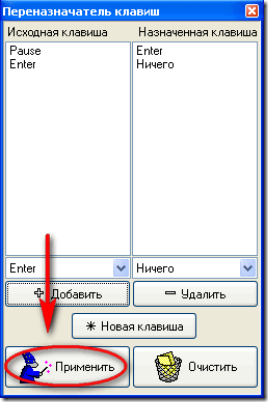 4.
Now in the list on the right side, find our disabled key Enter.
4.
Now in the list on the right side, find our disabled key Enter.
5. To complete the substitution of buttons, click on the "Add" button. The remapping list displays the result of the button replacement.
6. Now you need to disable the disabled button Enter... To do this, in the left list, select Enter-> in the right list select Nothing-> click on the add button. This is what should appear in the reassignment list:
7. To complete the reassignment operation, click on the “Apply” button -> close the program and restart your computer.
8. To cancel any reassignment, run the program -> select the required line -> click on the button “ Delete”. To completely return the keyboard to its original state, click on the button “ Clear”. Restart your computer for the changes to take effect.
I really value my readers and try not only to provide useful material, but also to entertain them with something. My next gift for you is called "What's behind the cheek?" (do not forget to comment if you liked it, or share with your friends using the social media buttons).
How to change the assignment of the PC keys?
The master's answer:
When buying a new computer, you may need to change the key assignments. This is especially true for new laptops, in which the keys may be located in an unusual mode for you. In order to change the assignment of the buttons on your keyboard, you will have to use special software.
Enter the "Start" menu, open the "Control Panel" and find the sub-item "Mouse" there. Through this menu, you can change the purpose of the buttons on your mouse, change the speed of the cursor, select its appearance and remove the shadow from its movement. If you have sub-items displayed by category, then the item "Mouse" will be in the category "Printers and other equipment". Changing mouse key assignments can be useful for people who use the left hand in their lives. This will be the most convenient option for them. There are also special mice that are created under the control of the left hand, but it is very difficult to find them.
To find special programs that are used to change key assignments, you can use the search. It is best to visit the manufacturer's official website and download the most latest version programs. The most the best program The one that does this job most quickly and efficiently is KeyTweak. Wait until setup file will download to your computer and start the installation process. Following all the instructions of the Installation Wizard, wait until the program is fully installed on your computer.
To start changing the assignment of buttons on the keyboard, launch this application using the shortcut on the desktop. A keyboard will appear in the main window of the program, on which you must select the key you want to change. By choosing desired button, you need to assign it to a specific character, and then press the Remap Key button.
If you want to revert to the original settings, you can use the Restore Default command. For any button, you can also assign not only a sign, but also a specific action. For example, for a button on numeric keypad, you can assign functions to shutdown the computer or enter standby mode. To do this, in the menu for changing the key assignment, you will need to select the action you need. The Power Off function is responsible for shutting down the computer.
If your keyboard is a multimedia keyboard, there are many additional buttons... By default, they are assigned calls to certain procedures or programs from a set of standard components operating system... You can also reassign the functions performed by these additional keys. You can use them at your own discretion. If you need to return to the default settings for key assignments, you need to set the default values.
Most conventional PS / 2 keyboards for fixed terminals or laptops come with standard settings. Even if the equipment breaks down, you can afford to buy new keyboard, because it costs a penny. With laptops, the situation is somewhat more complicated. Replacing the keyboard is not a cheap pleasure. Therefore, instead of buying it, you have to solve the problem of how Windows 7 or another system, if some buttons do not work. This can be done in several ways. But not all of them are very simple. At least in the native tools of Windows systems, you can get confused. But for the sake of completeness, consider all the ways.
What is key remapping for?
Let's start with laptops. The biggest problem is that different manufacturers add to keyboards additional keys or set standard buttons to execute different commands and started processes.
And especially the difference is felt when using Windows on computer Apple devices... But also in themselves Windows systems some buttons and keys have not been used by many users for a long time (for example, the same CapsLock button, which many press accidentally when typing). It is in such situations that you have to solve the problem of how to reassign keys to Windows keyboard 7 on a laptop or stationary terminal, or disable some buttons completely. It goes without saying that the proposed solutions can be used when the keys are inoperative, and some even specially "sharpen" their keyboards for more comfortable control of processes in modern computer games.
How do I remap keys on a Windows 7 keyboard without third-party software?
The first step is to consider the methodology proposed by the developer of Windows systems. To do this, you need to download a small applet designed to control the keyboard and pointing device (mouse) from the Microsoft website.
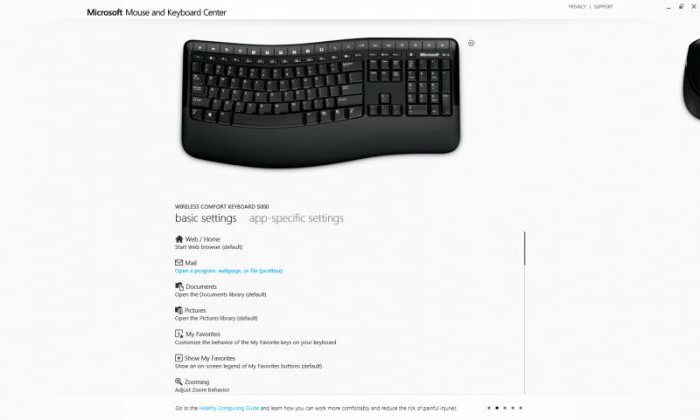
How do I remap keys on my Windows 7 keyboard using this app? It couldn't be easier! After starting the program, you need to select your device in the list and use the basic parameters. A list of current settings appears. To change the assignment of a command to a specific key, use the display of all commands. By selecting the button and the command you want, you just need to save the current setting. If a button deactivation is required, the button / key disable option is used.
How to remap keys on a Windows 7 keyboard: the registry
You don't need to use the above applet. By and large, the question of how to reassign 7 can also be resolved through the registry. But here some difficulties may arise, since for each key you need to know its scan code in hexadecimal expression.

So, first, the regedit command calls the registry editor (necessarily with administrator rights), after which you go along the HKLM branch through the SYSTEM and CurrentControlSet directories to the Keyboard Layout directory. To replace one code with another, here you need to create a new line parameter through the RMB menu in the right window, specifying the name Scancode Map for it, then enter the editing window, and in the window first enter the scan code of the key, the function of which will be performed after reassignment, then enter the code of the new key.

For example, to reassign a space to the right Alt, the combination looks like this: 0E 00 38 E0. To disable a key (let's take CapsLock as an example), the combination must start with four zeros and will look like 00 00 3A 00. As already clear, the process is quite laborious, since you need to know not only the codes and the order of their entry. The reassignment can only be done once, so you will have to create many new string parameters.
MapKeyboard app
In order not to deal with such complex procedures and solve the question of how to remap keys on the Windows 7 keyboard more in a simple way, it is better to use some of the utilities intended for this. One of these is small program MapKeyboard.
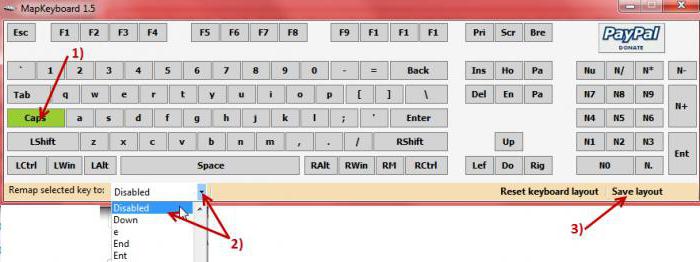
After starting the application, you will see virtual keyboard... First of all, you need to select a button or key, the function or symbol of which will be reassigned, then a new key is selected from the scrolling list to the right, called by the Remap selected key line, and then the Save layout action confirmation button is pressed. This will be followed by a notification about the reassignment, and the changes are activated only after a complete restart of the computer.
SharpKeys program
Another one simple program- SharpKeys. Alas, when deciding how to remap keys on the Windows 7 keyboard, the Fn-button in particular cannot be used. It is better to apply other solutions (the program does not recognize this key, and when changing Cyrillic letters, you need to use the same keys in the Latin layout).

Here the question of how to remap keys on the Windows 7 keyboard can be solved just as easily. First, the Add button is used, after which the "reassignable" button is selected, and in the list on the right - a new action or symbol (for complete shutdown used by the most top line Turn Key Off). Upon completion of the actions, the Write To Registry button is pressed (saving the parameters in system registry), and a reboot follows.
MKey Applet
Finally, another very interesting utility called MKey or Media Key. After installation, it will be in the system tray.

In the running program, the add button is pressed, then the key that needs to be reassigned is marked, after that the line of pressing emulation is marked, and a new button is selected from the list below. Now it remains to click on the button with the floppy disk at the very bottom to save the changes.
By the way, it is this program that allows you not only to reassign individual buttons. With its help, you can create your own "hot" combinations, including shortcuts with the Fn key, as well as customize any manipulators, gamepads and other similar equipment.
Instead of an afterword
It remains to find out the most important question: what exactly should you prefer to install such settings? I think most users will agree that using the registry editor is quite troublesome. And from the programs considered, it is perhaps best to choose MKey, since the application has wider capabilities compared to the first two applets and is fully Russified. By the way, please note that before using any of the presented methods, it is recommended that you first create a recovery point in case of an emergency. But in any program, even after reassignment, you can set the standard default parameters by full reset settings.
And, of course, only the most popular methods and programs were considered here, since today there are a lot of similar applications on the computer software market. But they all work according to similar principles, and the interface is not particularly different.
In this tutorial, I'll show you how you can remap the keys on your keyboard using free software SharpKeys is not difficult, and while it may seem useless, it is not.
For example, you can add multimedia actions to the most common keyboard: for example, if you are not using the numeric keypad on the right, you can use these keys to call the calculator, open My Computer or the browser, start playing music, or control actions when browsing the Internet. In addition, in the same way, you can disable the keys if they interfere with your work. For example, if you need to disable Caps lock, F1-F12 keys and any others, you can do it in the described way. Another possibility is to turn off or put the desktop computer to sleep with a single key on the keyboard (like on a laptop).
Using SharpKeys to Remap Keys
You can download the program for remapping SharpKeys keys from official page sharpkeys.codeplex.com. Installation of the program is not difficult, no additional and potentially unwanted software is installed (at least at the time of this writing).
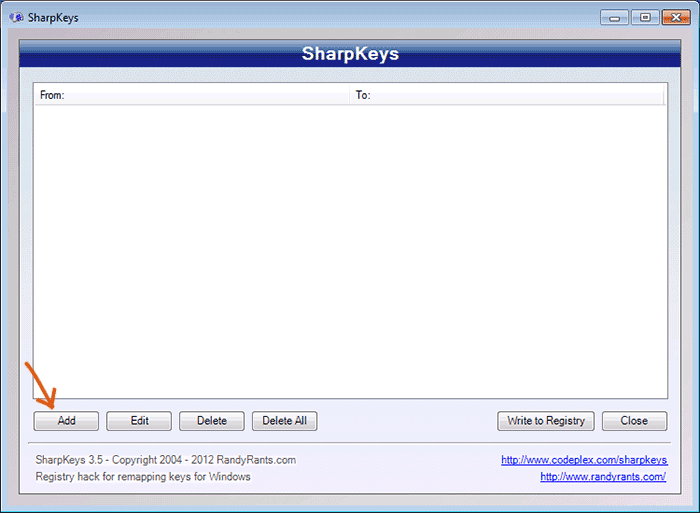
After starting the program, you will see an empty list, to reassign the keys and add them to this list, click the "Add" button. Now let's look at how to accomplish some simple and common tasks using this program.
How to disable the F1 key and the rest
I have come across the fact that someone needed to disable the F1 - F12 keys on a computer or laptop keyboard. Using this program, you can do this as follows.
After you clicked the "Add" button, a window with two lists will open - on the left are the keys that we are reassigning, and on the right are those to which. In this case, the lists will have more keys than there actually are on your keyboard.

In order to disable the F1 key, find and select "Function: F1" in the left list (the code of this key will be indicated next to it). And in the right list, select "Turn Key Off" and click "OK". Likewise, you can disable Caps Lock and any other key, all overrides will appear in a list in the main SharpKeys window.

After you are done with the assignments, click the "Write to Registry" button and then restart your computer for the changes to take effect. Yes, for reassignment, changing the standard registry settings is used and, in fact, all this can be done manually, knowing the key codes.
Create a hotkey to launch the calculator, open My Computer and other tasks
Another useful feature is the reassignment of unnecessary keys to perform useful tasks. For example, to assign the calculator launch to the Enter key located in the numeric part of a full-size keyboard, select “Num: Enter” in the list on the left, and “App: Calculator” in the list on the right.
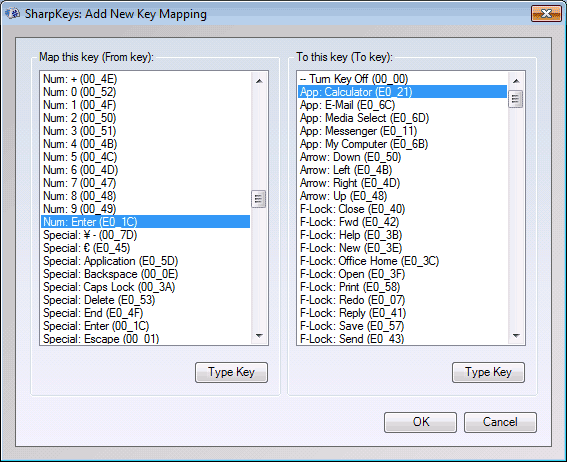
Likewise, here you can also find "My Computer" and launch the mail client and much more, including steps to shutdown the computer, call printing, and the like. Although all designations are on English language most users will understand them. You can apply the changes made in the same way as described in the previous example.
I think if someone sees the benefit for themselves, the examples given will be enough to achieve the result that was expected. Later, if you need to return to the default actions for the keyboard, run the program again, delete all changes made using the "Delete" button, click "Write to registry" and restart the computer.
The book contains and summarizes tips for solving various problems, which sooner or later arise in the operation of both economical netbooks and modern desktop models. All of the recipes given are field-tested and categorized by topic: hardware personal computers, computer networks and Internet connection, installing, configuring and repairing Windows OS, surfing the Internet, protecting against viruses. Considered not only ready-made solutions to sudden problems, but also answers to many questions that arise even before buying a computer. The required minimum is given technical data allowing you to make an informed decision.
The CD is included only with the printed edition of the book.
Book:
Sections on this page:
There are many keys on the keyboard that you never use. One of the most annoying is the key
Let's consider these actions by examples, and then we'll tell you how this is done in the general case - for any key.
First, you need to create a new binary parameter in the HKEY_LOCAL_MACHINESYSTEMCurrentControlSet ControlKeyboard Layout registry key (not to be confused with Keyboard Layouts!)
00 00 00 00 00 00 00 00
03 00 00 00 00 00 5C E0
00 00 5D E0 00 00 00 00
This line will disable the Windows checkbox key and the adjacent popup menu key. Let's figure out what is written here.
First, there should be 8 pairs of zeros in a row. Then comes a number (with a leading zero) - in this case 03, which means the number of keys to track plus one (that is, in this example, we are tracking two keys). It should always be followed by three pairs of zeros (complementing up to 4 pairs of numbers). The record must always end with four pairs of zeros. But between them, we must write as many fours of paired numbers as we have provided for tracking keys - in this case, two. They contain the so-called scan-codes of the keys that we want to disable. Table 12.2 shows the codes of those keys that are advisable to be considered in terms of candidates for disconnection or replacement (see below).
These codes are written in the last two pairs of every four pairs of numbers, the first two pairs are again zeros - as you can see in the sample. So the example line will disable our right key
Table 12.2. Key scan codes

What are scan codes and where to get them
The scan code is the number that the keyboard gives out when you press a certain key. Scan codes should not be confused with virtual key codes - the latter are formed already at the BIOS and Windows level and subsequently determine the character codes, the very ones that, for example, form the content text documents... In most cases, they are not related in any way. For example, the virtual code of the "space" key is 32 (the same as the code of the "space" character in single-byte encodings), and its scan code is 57 (in the HEX form it will be 20 and 39, respectively). Note that virtual codes are not equivalent to symbolic ones - in order to turn a virtual code into a character code, you also need to take into account the language layout, the state of the keys
For our purposes, scan codes, as you can guess from the table below, should be presented in hexadecimal (HEX), not decimal form. Tables of virtual codes and character codes are usually attached to any Windows programming tutorial, but a complete table of scan codes is not easy to find. One of these tables is located on the site " Digital library"At the link http://ntlib.chat.ru/ware/tables/scan.htm. It is a little unsuccessfully composed - the so-called extended keys (these are those with the second byte in our table equal to E0) are shown there by adding an extra digit equal to 1. That is, by selecting the scan code from the HEX column, for example, 11C (key
Of course, such a string of numbers should be prepared in advance and all pairs should be carefully recounted before entering it into the register. But as you type, you will see that it will help you not to make mistakes. Entering a value binary number is done manually (Fig. 12.11), but despite the unusual appearance of this editor, you will quickly see that it is very convenient to work with it. In particular, there are no problems when counting the entered pairs - they are automatically grouped at eight per line. Do not forget to restart the PC after the final setting of the parameter values.
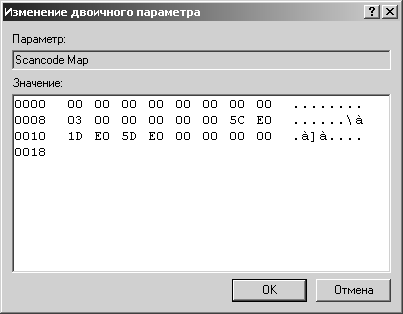
Rice. 12.11. Entering Binary Parameter Values
For not just cancellation, but also reassignment, you will have to complicate the recording a little - the first two pairs of zeros in those fours that contain the codes of the keys to be disabled should be replaced with those codes that, in your opinion, should work. For example, a Scancode Map value of
00 00 00 00 00 00 00 00
03 00 00 00 00 00 5C E0
1D E0 5D E0 00 00 00 00
will make it so that right key with the checkbox Windows will turn off and
Let's show you how to deal with
00 00 00 00 00 00 00 00
03 00 00 00 1D E0 5D E0
2A 00 3A 00 00 00 00 00
The key.reg file is located on the supplied disk in the Registry folder, when you run it and confirm that you really want to make changes to the registry, a Scancode Map parameter with this value will be automatically created. If you don't want to touch anything but
 Alternatives to Replace Microsoft Office Visio Command Line Key
Alternatives to Replace Microsoft Office Visio Command Line Key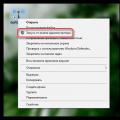 Mhotspot installation and setup Computer did not restart after installation
Mhotspot installation and setup Computer did not restart after installation A tale of three buttons. Column by Evgeny Zobnin. We get customizable on-screen buttons Home, Back and Menu on any Android device (Floating Soft Keys) Assigning buttons on the phone
A tale of three buttons. Column by Evgeny Zobnin. We get customizable on-screen buttons Home, Back and Menu on any Android device (Floating Soft Keys) Assigning buttons on the phone